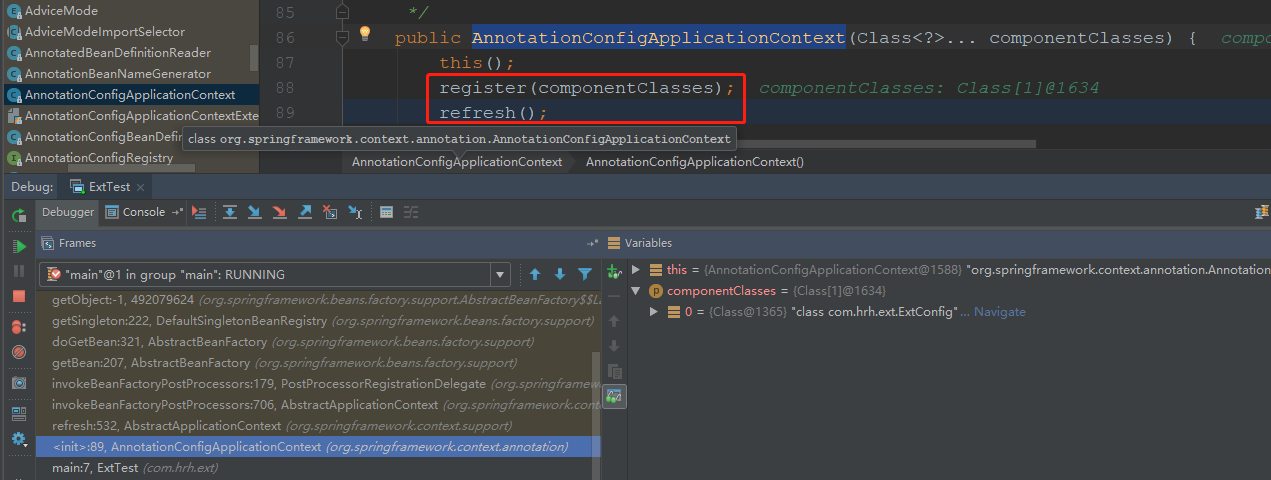Spring笔记(6) - Spring的BeanFactoryPostProcessor探究
一.背景
在说BeanFactoryPostProcessor之前,先来说下BeanPostProcessor,在前文Spring笔记(2) - 生命周期/属性赋值/自动装配及部分源码解析中讲解了BeanPostProcessor是一个bean后置处理器(bean创建对象初始化前后进行拦截工作)。
BeanPostProcessor的运行流程如下:
1)Spring IOC容器实例化Bean;
2)调用BeanPostProcessor的postProcessBeforeInitialization方法;
3)调用bean实例的初始化方法;
4)调用BeanPostProcessor的postProcessAfterInitialization方法;
实现BeanPostProcessor接口可以在Bean(实例化之后)初始化的前后做一些自定义的操作,但是拿到的参数只有BeanDefinition实例和BeanDefinition的名称,也就是无法修改BeanDefinition元数据,这里说的Bean的初始化是:
1)bean实现了InitializingBean接口,对应的方法为afterPropertiesSet
2)在bean定义的时候,通过init-method设置的方法
Spring中Bean的实例化过程图示:

那么BeanFactoryPostProcessor顾名思义就是bean工厂的后置处理器,说通俗一些就是可以管理我们的bean工厂内所有的BeanDefinition(未实例化)数据,可以随心所欲的修改属性。
Spring容器初始化时,从资源中读取到bean的相关定义后,保存在beanFactory的成员变量中(参考DefaultListableBeanFactory类的成员变量beanDefinitionMap),在实例化bean的操作就是依据这些bean的定义来做的,而在实例化之前,Spring允许我们通过自定义扩展来改变bean的定义,定义一旦变了,后面的实例也就变了,而beanFactory后置处理器,即BeanFactoryPostProcessor就是用来改变bean定义的;如果业务需要,可以配置多个BeanFactoryPostProcessor的实现类,通过”order”控制执行次序(要实现Ordered接口)。
注册一个BeanFactoryPostProcessor实例需要定义一个Java类来实现BeanFactoryPostProcessor接口,并重写该接口的postProcessorBeanFactory方法。通过beanFactory可以获取bean的定义信息,并可以修改bean的定义信息。(这点是和BeanPostProcessor最大区别)
所以通过上面的介绍可以总结出有两种方式可以对bean做控制(例如修改某个成员变量):
1. 只改变实例化的对象(BeanPostProcessor接口);
2. 改变bean的定义(BeanFactoryPostProcessor接口) ,可以想象成修改了class文件,这样实例化出来的每个对象都变了;
PS:BeanFactoryPostProcessor回调会先于BeanPostProcessor
下面是BeanFactoryPostProcessor的源码:
public interface BeanFactoryPostProcessor { /** * Modify the application context's internal bean factory after its standard * initialization. All bean definitions will have been loaded, but no beans * will have been instantiated yet. This allows for overriding or adding * properties even to eager-initializing beans. * @param beanFactory the bean factory used by the application context * @throws org.springframework.beans.BeansException in case of errors */ //在ioc容器的bean Factory标准初始化之后可以对它们进行修改。所有的bean定义被加载了,但还没有被实例化。 //允许进行重载或添加属性即使在eager-initializing beans void postProcessBeanFactory(ConfigurableListableBeanFactory beanFactory) throws BeansException; }
BeanFactoryPostProcessor此接口只提供了一个方法,方法参数为ConfigurableListableBeanFactory,下面是该类的源码:
public interface ConfigurableListableBeanFactory extends ListableBeanFactory, AutowireCapableBeanFactory, ConfigurableBeanFactory { void ignoreDependencyType(Class<?> type); void ignoreDependencyInterface(Class<?> ifc); void registerResolvableDependency(Class<?> dependencyType, @Nullable Object autowiredValue); boolean isAutowireCandidate(String beanName, DependencyDescriptor descriptor) throws NoSuchBeanDefinitionException; BeanDefinition getBeanDefinition(String beanName) throws NoSuchBeanDefinitionException; Iterator<String> getBeanNamesIterator(); void clearMetadataCache(); void freezeConfiguration(); boolean isConfigurationFrozen(); void preInstantiateSingletons() throws BeansException; }
其中有个方法名为getBeanDefinition的方法,我们可以根据此方法,找到我们定义bean的BeanDefinition对象。然后我们可以对定义的属性进行修改,以下是BeanDefinition中的方法:

public interface BeanDefinition extends AttributeAccessor, BeanMetadataElement { /** * Scope identifier for the standard singleton scope: "singleton". * <p>Note that extended bean factories might support further scopes. * @see #setScope */ String SCOPE_SINGLETON = ConfigurableBeanFactory.SCOPE_SINGLETON; /** * Scope identifier for the standard prototype scope: "prototype". * <p>Note that extended bean factories might support further scopes. * @see #setScope */ String SCOPE_PROTOTYPE = ConfigurableBeanFactory.SCOPE_PROTOTYPE; /** * Role hint indicating that a {@code BeanDefinition} is a major part * of the application. Typically corresponds to a user-defined bean. */ int ROLE_APPLICATION = 0; /** * Role hint indicating that a {@code BeanDefinition} is a supporting * part of some larger configuration, typically an outer * {@link org.springframework.beans.factory.parsing.ComponentDefinition}. * {@code SUPPORT} beans are considered important enough to be aware * of when looking more closely at a particular * {@link org.springframework.beans.factory.parsing.ComponentDefinition}, * but not when looking at the overall configuration of an application. */ int ROLE_SUPPORT = 1; /** * Role hint indicating that a {@code BeanDefinition} is providing an * entirely background role and has no relevance to the end-user. This hint is * used when registering beans that are completely part of the internal workings * of a {@link org.springframework.beans.factory.parsing.ComponentDefinition}. */ int ROLE_INFRASTRUCTURE = 2; // Modifiable attributes /** * Set the name of the parent definition of this bean definition, if any. */ void setParentName(@Nullable String parentName); /** * Return the name of the parent definition of this bean definition, if any. */ @Nullable String getParentName(); /** * Specify the bean class name of this bean definition. * <p>The class name can be modified during bean factory post-processing, * typically replacing the original class name with a parsed variant of it. * @see #setParentName * @see #setFactoryBeanName * @see #setFactoryMethodName */ void setBeanClassName(@Nullable String beanClassName); /** * Return the current bean class name of this bean definition. * <p>Note that this does not have to be the actual class name used at runtime, in * case of a child definition overriding/inheriting the class name from its parent. * Also, this may just be the class that a factory method is called on, or it may * even be empty in case of a factory bean reference that a method is called on. * Hence, do <i>not</i> consider this to be the definitive bean type at runtime but * rather only use it for parsing purposes at the individual bean definition level. * @see #getParentName() * @see #getFactoryBeanName() * @see #getFactoryMethodName() */ @Nullable String getBeanClassName(); /** * Override the target scope of this bean, specifying a new scope name. * @see #SCOPE_SINGLETON * @see #SCOPE_PROTOTYPE */ void setScope(@Nullable String scope); /** * Return the name of the current target scope for this bean, * or {@code null} if not known yet. */ @Nullable String getScope(); /** * Set whether this bean should be lazily initialized. * <p>If {@code false}, the bean will get instantiated on startup by bean * factories that perform eager initialization of singletons. */ void setLazyInit(boolean lazyInit); /** * Return whether this bean should be lazily initialized, i.e. not * eagerly instantiated on startup. Only applicable to a singleton bean. */ boolean isLazyInit(); /** * Set the names of the beans that this bean depends on being initialized. * The bean factory will guarantee that these beans get initialized first. */ void setDependsOn(@Nullable String... dependsOn); /** * Return the bean names that this bean depends on. */ @Nullable String[] getDependsOn(); /** * Set whether this bean is a candidate for getting autowired into some other bean. * <p>Note that this flag is designed to only affect type-based autowiring. * It does not affect explicit references by name, which will get resolved even * if the specified bean is not marked as an autowire candidate. As a consequence, * autowiring by name will nevertheless inject a bean if the name matches. */ void setAutowireCandidate(boolean autowireCandidate); /** * Return whether this bean is a candidate for getting autowired into some other bean. */ boolean isAutowireCandidate(); /** * Set whether this bean is a primary autowire candidate. * <p>If this value is {@code true} for exactly one bean among multiple * matching candidates, it will serve as a tie-breaker. */ void setPrimary(boolean primary); /** * Return whether this bean is a primary autowire candidate. */ boolean isPrimary(); /** * Specify the factory bean to use, if any. * This the name of the bean to call the specified factory method on. * @see #setFactoryMethodName */ void setFactoryBeanName(@Nullable String factoryBeanName); /** * Return the factory bean name, if any. */ @Nullable String getFactoryBeanName(); /** * Specify a factory method, if any. This method will be invoked with * constructor arguments, or with no arguments if none are specified. * The method will be invoked on the specified factory bean, if any, * or otherwise as a static method on the local bean class. * @see #setFactoryBeanName * @see #setBeanClassName */ void setFactoryMethodName(@Nullable String factoryMethodName); /** * Return a factory method, if any. */ @Nullable String getFactoryMethodName(); /** * Return the constructor argument values for this bean. * <p>The returned instance can be modified during bean factory post-processing. * @return the ConstructorArgumentValues object (never {@code null}) */ ConstructorArgumentValues getConstructorArgumentValues(); /** * Return if there are constructor argument values defined for this bean. * @since 5.0.2 */ default boolean hasConstructorArgumentValues() { return !getConstructorArgumentValues().isEmpty(); } /** * Return the property values to be applied to a new instance of the bean. * <p>The returned instance can be modified during bean factory post-processing. * @return the MutablePropertyValues object (never {@code null}) */ MutablePropertyValues getPropertyValues(); /** * Return if there are property values values defined for this bean. * @since 5.0.2 */ default boolean hasPropertyValues() { return !getPropertyValues().isEmpty(); } /** * Set the name of the initializer method. * @since 5.1 */ void setInitMethodName(@Nullable String initMethodName); /** * Return the name of the initializer method. * @since 5.1 */ @Nullable String getInitMethodName(); /** * Set the name of the destroy method. * @since 5.1 */ void setDestroyMethodName(@Nullable String destroyMethodName); /** * Return the name of the destroy method. * @since 5.1 */ @Nullable String getDestroyMethodName(); /** * Set the role hint for this {@code BeanDefinition}. The role hint * provides the frameworks as well as tools with an indication of * the role and importance of a particular {@code BeanDefinition}. * @since 5.1 * @see #ROLE_APPLICATION * @see #ROLE_SUPPORT * @see #ROLE_INFRASTRUCTURE */ void setRole(int role); /** * Get the role hint for this {@code BeanDefinition}. The role hint * provides the frameworks as well as tools with an indication of * the role and importance of a particular {@code BeanDefinition}. * @see #ROLE_APPLICATION * @see #ROLE_SUPPORT * @see #ROLE_INFRASTRUCTURE */ int getRole(); /** * Set a human-readable description of this bean definition. * @since 5.1 */ void setDescription(@Nullable String description); /** * Return a human-readable description of this bean definition. */ @Nullable String getDescription(); // Read-only attributes /** * Return a resolvable type for this bean definition, * based on the bean class or other specific metadata. * <p>This is typically fully resolved on a runtime-merged bean definition * but not necessarily on a configuration-time definition instance. * @return the resolvable type (potentially {@link ResolvableType#NONE}) * @since 5.2 * @see ConfigurableBeanFactory#getMergedBeanDefinition */ ResolvableType getResolvableType(); /** * Return whether this a <b>Singleton</b>, with a single, shared instance * returned on all calls. * @see #SCOPE_SINGLETON */ boolean isSingleton(); /** * Return whether this a <b>Prototype</b>, with an independent instance * returned for each call. * @since 3.0 * @see #SCOPE_PROTOTYPE */ boolean isPrototype(); /** * Return whether this bean is "abstract", that is, not meant to be instantiated. */ boolean isAbstract(); /** * Return a description of the resource that this bean definition * came from (for the purpose of showing context in case of errors). */ @Nullable String getResourceDescription(); /** * Return the originating BeanDefinition, or {@code null} if none. * Allows for retrieving the decorated bean definition, if any. * <p>Note that this method returns the immediate originator. Iterate through the * originator chain to find the original BeanDefinition as defined by the user. */ @Nullable BeanDefinition getOriginatingBeanDefinition(); }
我们可以在上面代码中发现里面的方法名字类似bean标签的属性,setBeanClassName对应bean标签中的class属性,所以当我们拿到BeanDefinition对象时,我们可以手动修改bean标签中所定义的属性值。
具体这个BeanDefinition是个什么对象,当我们在xml中定义了bean标签时,Spring会把这些bean标签解析成一个javabean,这个BeanDefinition就是bean标签对应的javabean。
所以当我们调用BeanFactoryPostProcess方法时,这时候bean还没有实例化,此时bean刚被解析成BeanDefinition对象。
Spring容器初始化bean大致过程 :
1)定义bean标签
2)将bean标签解析成BeanDefinition
3)调用构造方法实例化(IOC)
4)属性值得依赖注入(DI)
所以可以看出BeanFactoryPostProcess方法的执行是发生在第二步之后,第三步之前。
综上所述BeanPostProcessor和BeanFactoryPostProcess都是为Spring提供的后处理bean的接口,只是两者执行的时机不一样。BeanPostProcessor为实例化之后,BeanFactoryPostProcess是实例化之前。功能上,BeanFactoryPostProcess对bean的处理功能更加强大。
二.案例
1.配置类:进行包扫描将类加载到容器中
@ComponentScan("com.hrh.ext")
@Configuration
public class ExtConfig {
@Bean
public Person person() {
return new Person("张三", "男");
}
}
2.实体类:
public class Person implements InitializingBean, DisposableBean, BeanNameAware, BeanFactoryAware { private String name; private String sex; public Person() { System.out.println("Person无参构造器"); } public Person(String name, String sex) { System.out.println("Person有参构造器:[name=" + name + ",sex=" + sex + "]"); } public String getName() { return name; } public void setName(String name) { this.name = name; } public String getSex() { return sex; } public void setSex(String sex) { this.sex = sex; } @Override public void setBeanFactory(BeanFactory beanFactory) throws BeansException { System.out.println("[Person]调用了BeanFactoryAware的setBeanFactory方法了:" + beanFactory); } @Override public void setBeanName(String name) { System.out.println("[Person]调用了BeanNameAware的setBeanName方法了:" + name); } @Override public void destroy() throws Exception { System.out.println("[Person]调用了DisposableBean的destroy方法了"); } @Override public void afterPropertiesSet() throws Exception { System.out.println("[Person]调用了Initailization的afterPropertiesSet方法了"); } @Override public String toString() { return "Person [name=" + name + ", sex=" + sex + "]"; } }
3.自定义BeanFactoryPostProcessor类:
@Component public class MyBeanFactoryPostProcessor implements BeanFactoryPostProcessor { @Override public void postProcessBeanFactory(ConfigurableListableBeanFactory beanFactory) throws BeansException { System.out.println("[MyBeanFactoryPostProcessor]调用了postProcessBeanFactory"); int count = beanFactory.getBeanDefinitionCount(); System.out.println("[MyBeanFactoryPostProcessor]当前beanFactory共有" + count + "个bean"); String[] beanDefinitionNames = beanFactory.getBeanDefinitionNames(); System.out.println("[MyBeanFactoryPostProcessor]当前beanFactory有下面组件" + Arrays.asList(beanDefinitionNames)); //获取容器中所有的beanDefinition for (String beanName : beanDefinitionNames) { if ("person".equals(beanName)) { //获取PersonDefinition对象 BeanDefinition beanDefinition = beanFactory.getBeanDefinition(beanName); MutablePropertyValues propertyValues = beanDefinition.getPropertyValues(); System.out.println(propertyValues.toString()); //修改定义中的name属性值 propertyValues.addPropertyValue("name", "赵四"); System.out.println("[MyBeanFactoryPostProcessor]postProcessBeanFactory方法中修改了name属性初始值了"); System.out.println(propertyValues.toString()); } } } }
4.自定义BeanPostProcessor类:
@Component public class MyBeanPostProcessor implements BeanPostProcessor { @Override public Object postProcessBeforeInitialization(Object bean, String beanName) throws BeansException { System.out.println("[MyBeanPostProcessor]后置处理器处理bean=【" + beanName + "】开始"); return bean; } @Override public Object postProcessAfterInitialization(Object bean, String beanName) throws BeansException { System.out.println("[MyBeanPostProcessor]后置处理器处理bean=【" + beanName + "】完毕!"); return bean; } }
5.测试:
public static void main(String[] args) { AnnotationConfigApplicationContext context = new AnnotationConfigApplicationContext(ExtConfig.class); Person bean = context.getBean(Person.class); System.out.println(bean.toString()); context.close(); } ======运行结果====== [MyBeanFactoryPostProcessor]调用了postProcessBeanFactory [MyBeanFactoryPostProcessor]当前beanFactory共有9个bean [MyBeanFactoryPostProcessor]当前beanFactory有下面组件[org.springframework.context.annotation.internalConfigurationAnnotationProcessor, org.springframework.context.annotation.internalAutowiredAnnotationProcessor, org.springframework.context.annotation.internalCommonAnnotationProcessor, org.springframework.context.event.internalEventListenerProcessor, org.springframework.context.event.internalEventListenerFactory, extConfig, myBeanFactoryPostProcessor, myBeanPostProcessor, person] PropertyValues: length=0 [MyBeanFactoryPostProcessor]postProcessBeanFactory方法中修改了name属性初始值了 PropertyValues: length=1; bean property 'name' [MyBeanPostProcessor]后置处理器处理bean=【extConfig】开始 [MyBeanPostProcessor]后置处理器处理bean=【extConfig】完毕! Person有参构造器:[name=张三,sex=男] [Person]调用了BeanNameAware的setBeanName方法了:person [Person]调用了BeanFactoryAware的setBeanFactory方法了:org.springframework.beans.factory.support.DefaultListableBeanFactory@e45f292: defining beans [org.springframework.context.annotation.internalConfigurationAnnotationProcessor,org.springframework.context.annotation.internalAutowiredAnnotationProcessor,org.springframework.context.annotation.internalCommonAnnotationProcessor,org.springframework.context.event.internalEventListenerProcessor,org.springframework.context.event.internalEventListenerFactory,extConfig,myBeanFactoryPostProcessor,myBeanPostProcessor,person]; root of factory hierarchy [MyBeanPostProcessor]后置处理器处理bean=【person】开始 [Person]调用了Initailization的afterPropertiesSet方法了 [MyBeanPostProcessor]后置处理器处理bean=【person】完毕! Person [name=赵四, sex=null] [Person]调用了DisposableBean的destroy方法了
从上面的运行结果可以看出:
1)Person的name值由"张三"变为"赵四";
2)BeanFactoryPostProcessor方法执行顺序先于BeanPostProcessor接口中方法,且在bean实例化之前执行;
3)BeanFactoryPostProcessor改变bean的定义,实例化出来的对象变了:“Person有参构造器:[name=张三,sex=男] ”变成了“Person [name=赵四, sex=null]”
4)BeanPostProcessor在bean创建对象实例化后,初始化(bean执行afterPropertiesSet方法或init-method方法)前后进行拦截工作;
三.原理
接下来我们通过debug代码来查看BeanFactoryPostProcessor的执行流程,从AbstractApplicationContext类的构造器方法看起,这里面对应着容器初始化的基本操作;
1.在测试main方法中下面的代码打断点:
AnnotationConfigApplicationContext context = new AnnotationConfigApplicationContext(ExtConfig.class);
2.从下图可以看出容器先注册配置类ExtConfig的定义信息,然后进行refresh刷新容器;

3.先来看看register(componentClasses)注册流程:从class文件读取信息解析成beanDefinition
AnnotationConfigApplicationContext: public void register(Class<?>... componentClasses) { Assert.notEmpty(componentClasses, "At least one component class must be specified"); this.reader.register(componentClasses); } AnnotatedBeanDefinitionReader:注册beanDefinition public void register(Class<?>... componentClasses) { for (Class<?> componentClass : componentClasses) { registerBean(componentClass); } } public void registerBean(Class<?> beanClass) { doRegisterBean(beanClass, null, null, null, null); } //Register a bean from the given bean class, deriving its metadata from class-declared annotations. //从class文件中读取bean的定义信息,并注册到容器中 private <T> void doRegisterBean(Class<T> beanClass, @Nullable String name, @Nullable Class<? extends Annotation>[] qualifiers, @Nullable Supplier<T> supplier, @Nullable BeanDefinitionCustomizer[] customizers) { //得到bean的所有定义信息:元数据metadata、作用域scope、初始化方法名字initMethodName等等 AnnotatedGenericBeanDefinition abd = new AnnotatedGenericBeanDefinition(beanClass); if (this.conditionEvaluator.shouldSkip(abd.getMetadata())) { return; } //为bean实例创建一个特殊的回调信号 abd.setInstanceSupplier(supplier); //获取作用域的数据:单例 ScopeMetadata scopeMetadata = this.scopeMetadataResolver.resolveScopeMetadata(abd); //设置bean为单例 abd.setScope(scopeMetadata.getScopeName()); //获取beanName String beanName = (name != null ? name : this.beanNameGenerator.generateBeanName(abd, this.registry)); //处理一些注释信息:lazyInit、primary、dependsOn、role、description AnnotationConfigUtils.processCommonDefinitionAnnotations(abd); if (qualifiers != null) {//qualifiers = nul 跳过 for (Class<? extends Annotation> qualifier : qualifiers) { if (Primary.class == qualifier) { abd.setPrimary(true); } else if (Lazy.class == qualifier) { abd.setLazyInit(true); } else { abd.addQualifier(new AutowireCandidateQualifier(qualifier)); } } } if (customizers != null) {//customizers = null跳过 for (BeanDefinitionCustomizer customizer : customizers) { customizer.customize(abd); } } //创建一个BeanDefinitionHolder BeanDefinitionHolder definitionHolder = new BeanDefinitionHolder(abd, beanName); definitionHolder = AnnotationConfigUtils.applyScopedProxyMode(scopeMetadata, definitionHolder, this.registry); //容器中注册beanDefinition BeanDefinitionReaderUtils.registerBeanDefinition(definitionHolder, this.registry); }
4.refresh刷新容器:invokeBeanFactoryPostProcessors方法用来找出所有beanFactory后置处理器,并且调用这些处理器来改变bean的定义
public void refresh() throws BeansException, IllegalStateException { //来个锁,不然 refresh() 还没结束,你又来个启动或销毁容器的操作,那不就乱套了嘛 synchronized (this.startupShutdownMonitor) { // Prepare this context for refreshing. //容器刷新前的处理方法:获取启动的系统时间、设置active活跃标识、开始打印日志、设置环境变量、设置容器监听器、设置容器事件 prepareRefresh(); // Tell the subclass to refresh the internal bean factory. //刷新bean工厂并获取到bean工厂 ConfigurableListableBeanFactory beanFactory = obtainFreshBeanFactory(); // Prepare the bean factory for use in this context. // bean工厂的初始化操作:设置类加载器、设置bean表达式解析器、设置bean后置处理器等等; prepareBeanFactory(beanFactory); try { // Allows post-processing of the bean factory in context subclasses. // 【这里需要知道 BeanFactoryPostProcessor 这个知识点,Bean 如果实现了此接口, // 那么在容器初始化以后,Spring 会负责调用里面的 postProcessBeanFactory 方法。】 // 这里是提供给子类的扩展点,到这里的时候,所有的 Bean 都加载、注册完成了,但是都还没有初始化 // 具体的子类可以在这步的时候根据自身业务添加或修改一些特殊的 beanFactory属性 postProcessBeanFactory(beanFactory); // Invoke factory processors registered as beans in the context. //找出所有beanFactory后置处理器,并且调用这些处理器来改变bean的定义 invokeBeanFactoryPostProcessors(beanFactory); // Register bean processors that intercept bean creation.
//注册bean后置处理器 registerBeanPostProcessors(beanFactory); // Initialize message source for this context.
//初始化容器的信息源 initMessageSource(); // Initialize event multicaster for this context.
//初始化事件监听多路广播器 initApplicationEventMulticaster(); // Initialize other special beans in specific context subclasses.
//是个空壳方法,在AnnotationApplicationContex上下文中没有实现,可能在spring后面的版本会去扩展。
//与Web上下文有关 onRefresh(); // Check for listener beans and register them. //注册监听器 registerListeners(); // Instantiate all remaining (non-lazy-init) singletons. //对象的创建:初始化剩下所有的(非懒加载的)单实例对象【从这里可以看出beanFactory后置处理器在初始化其他组件之前执行】 finishBeanFactoryInitialization(beanFactory); // Last step: publish corresponding event.
//刷新完成工作,包括初始化LifecycleProcessor,发布刷新完成事件等 finishRefresh(); } catch (BeansException ex) { if (logger.isWarnEnabled()) { logger.warn("Exception encountered during context initialization - " + "cancelling refresh attempt: " + ex); } // Destroy already created singletons to avoid dangling resources.
//销毁已经初始化的 singleton 的 Beans,以免有些 bean 会一直占用资源 destroyBeans(); // Reset 'active' flag.
//取消刷新的标志 cancelRefresh(ex); // Propagate exception to caller. throw ex; } finally { // Reset common introspection caches in Spring's core, since we // might not ever need metadata for singleton beans anymore... resetCommonCaches(); } } }
5.打开invokeBeanFactoryPostProcessors方法,如下所示,实际操作是委托PostProcessorRegis
trationDelegate去完成的:调用getBeanFactoryPostProcessors()方法获取手工注册到ApplicationCon
text的容器后置处理器集合
protected void invokeBeanFactoryPostProcessors(ConfigurableListableBeanFactory beanFactory) { PostProcessorRegistrationDelegate.invokeBeanFactoryPostProcessors(beanFactory, getBeanFactoryPostProcessors()); // Detect a LoadTimeWeaver and prepare for weaving, if found in the meantime // (e.g. through an @Bean method registered by ConfigurationClassPostProcessor) if (beanFactory.getTempClassLoader() == null && beanFactory.containsBean(LOAD_TIME_WEAVER_BEAN_NAME)) { beanFactory.addBeanPostProcessor(new LoadTimeWeaverAwareProcessor(beanFactory)); beanFactory.setTempClassLoader(new ContextTypeMatchClassLoader(beanFactory.getBeanClassLoader())); } }
1)在调用PostProcessorRegistrationDelegate类的invokeBeanFactoryPostProcessors方法时,注意第二个入参是getBeanFactoryPostProcessors()方法,该方法返回的是applicationContext的成员变量beanFactoryPostProcessors,该成员变量的值来自AbstractApplicationContext.addBeanFactoryPostProcessor方法被调用的时候:
private final List<BeanFactoryPostProcessor> beanFactoryPostProcessors = new ArrayList<>(); @Override public void addBeanFactoryPostProcessor(BeanFactoryPostProcessor postProcessor) { Assert.notNull(postProcessor, "BeanFactoryPostProcessor must not be null"); this.beanFactoryPostProcessors.add(postProcessor); } public List<BeanFactoryPostProcessor> getBeanFactoryPostProcessors() { return this.beanFactoryPostProcessors; }
2)AbstractApplicationContext.addBeanFactoryPostProcessor方法是留给业务扩展时调用的,例如在springboot初始化时,ConfigurationWarningsApplicationContextInitializer类的initialize方法中就有调用:
@Override public void initialize(ConfigurableApplicationContext context) { context.addBeanFactoryPostProcessor( new ConfigurationWarningsPostProcessor(getChecks())); }
6.看过了如何添加BeanFactoryPostProcessor,再回到PostProcessorRegistrationDelegate.invok
eBeanFactoryPostProcessors方法:实例化并调用所有已注册的BeanFactoryPostProcessor bean;
流程是:
1)beanFactory是BeanDefinitionRegistry类型时,此条件下完成如下流程:
1.遍历传入后置处理器集合查找类型为BeanDefinitionRegistryPostProcessor的后置处理器,调用后置处理器的postProcessBeanDefinitionRegistry方法;
2.在容器中查找所有的实现了PriorityOrdered接口的BeanDefinition
RegistryPostProcessor集合,对后置处理器集合排序,遍历,执行后置处理的postProcessBeanDefinitionRegistry方法;
3.在容器中查找所有实现了Ordered接口的BeanDefinitionRegistryPostProcessor集合,对后置处理器集合排序,遍历,执行后置处理的postProcessBeanDefinitionRegistry方法;
4.在容器中查找其它(未实现排序接口)的BeanDefinitionRegistryPostProcessor并添加到集合nonOrderedPostProcessors中,对后置处理器集合排序,遍历,执行后置处理的postProcessBeanDefinitionRegistry方法;
5.当前所有的BeanDefinitionRegistryPostProcessor处理器的方法postProcessBeanD
efinitionRegistry 执行完毕后,执行其父类postProcessBeanFactory方法;
6.执行所有非BeanDefinitionRegistryPostProcessor类型的后置处理器的postProcessB
eanFactory方法;
PS:BeanDefinitionRegistryPostProcessor的简介(BeanDefinitionRegistryPostProc
essor的实现案例请查看下文第7点的后文)
(1)我们开发的类,如果想注册到spring容器,让spring来完成实例化,常用方式如下:xml中通过bean节点来配置;使用@Service、@Controller、@Conponent等注解;
其实,除了以上方式,spring还支持我们通过代码来将指定的类注册到spring容器中,即使用BeanDefinitionRegistryPostProcessor来进行bean的注册;
(2)BeanDefinitionRegistryPostProcessor是BeanFactoryPostProcessor的子类,执行顺序优先于BeanFactoryPostProcessor,执行流程跟BeanFactoryPostProcessor一样,只是会先执行postProcessBeanDefinitionRegistry再执行postProcessBeanFactory;
(3)BeanDefinitionRegistry提供了丰富的方法来操作bean定义,判断、注册、反注册等方法都准备好了,我们在编写postProcessBeanDefinitionRegistry方法的内容时,就能直接使用入参registry的这些方法来完成判断和注册、反注册等操作;

public interface BeanDefinitionRegistryPostProcessor extends BeanFactoryPostProcessor { //执行时机:在所有bean定义信息将要被加载,bean实例还未创建,利用下面方法给容器再额外添加一些组件 void postProcessBeanDefinitionRegistry(BeanDefinitionRegistry registry) throws BeansException; }
2)beanFactory非BeanDefinitionRegistry类型时,此条件下完成如下流程:
1.遍历传入后置处理器集合,执行后置处理器的postProcessBeanFactory方法;
2.在容器中(beanFactory.getBeanNamesForType)查找所有的实现了PriorityOrdered接口的BeanFactoryPostProcessor集合,对后置处理器集合排序,遍历,执行后置处理;
3.在容器中查找所有实现了Ordered接口的BeanFactoryPostProcessor集合,对后置处理器集合排序,遍历,执行后置处理;
4.在容器中查找其它(未实现排序接口)的BeanFactoryPostProcessor并添加到集合nonOrderedPostProcessors中,对后置处理器集合排序,遍历,执行后置处理;
public static void invokeBeanFactoryPostProcessors( ConfigurableListableBeanFactory beanFactory, List<BeanFactoryPostProcessor> beanFactoryPostProcessors) { // Invoke BeanDefinitionRegistryPostProcessors first, if any. Set<String> processedBeans = new HashSet<>(); //如果beanFactory实现了BeanDefinitionRegistry if (beanFactory instanceof BeanDefinitionRegistry) { BeanDefinitionRegistry registry = (BeanDefinitionRegistry) beanFactory; List<BeanFactoryPostProcessor> regularPostProcessors = new ArrayList<>(); List<BeanDefinitionRegistryPostProcessor> registryProcessors = new ArrayList<>(); for (BeanFactoryPostProcessor postProcessor : beanFactoryPostProcessors) { //如果beanFactoryPostProcessor实现了BeanDefinitionRegistryPostProcessor,分别放入两个集合:registryProcessors 和 regularPostProcessors if (postProcessor instanceof BeanDefinitionRegistryPostProcessor) { BeanDefinitionRegistryPostProcessor registryProcessor = (BeanDefinitionRegistryPostProcessor) postProcessor; registryProcessor.postProcessBeanDefinitionRegistry(registry); registryProcessors.add(registryProcessor); } else { regularPostProcessors.add(postProcessor); } } // Do not initialize FactoryBeans here: We need to leave all regular beans // uninitialized to let the bean factory post-processors apply to them! // Separate between BeanDefinitionRegistryPostProcessors that implement // PriorityOrdered, Ordered, and the rest. List<BeanDefinitionRegistryPostProcessor> currentRegistryProcessors = new ArrayList<>(); // First, invoke the BeanDefinitionRegistryPostProcessors that implement PriorityOrdered. //找出所有实现了BeanDefinitionRegistryPostProcessor接口和PriorityOrdered接口的bean,放入registryProcessors集合, //放入根据Set接口来排序,然后这些bean会被invokeBeanDefinitionRegistryPostProcessors方法执行; String[] postProcessorNames = beanFactory.getBeanNamesForType(BeanDefinitionRegistryPostProcessor.class, true, false); for (String ppName : postProcessorNames) { if (beanFactory.isTypeMatch(ppName, PriorityOrdered.class)) { currentRegistryProcessors.add(beanFactory.getBean(ppName, BeanDefinitionRegistryPostProcessor.class)); processedBeans.add(ppName); } } sortPostProcessors(currentRegistryProcessors, beanFactory); registryProcessors.addAll(currentRegistryProcessors); invokeBeanDefinitionRegistryPostProcessors(currentRegistryProcessors, registry); currentRegistryProcessors.clear(); // Next, invoke the BeanDefinitionRegistryPostProcessors that implement Ordered. //找出所有实现了BeanDefinitionRegistryPostProcessor接口和Ordered接口的bean,放入registryProcessors集合, //放入根据Set接口来排序,然后这些bean会被invokeBeanDefinitionRegistryPostProcessors方法执行; postProcessorNames = beanFactory.getBeanNamesForType(BeanDefinitionRegistryPostProcessor.class, true, false); for (String ppName : postProcessorNames) { if (!processedBeans.contains(ppName) && beanFactory.isTypeMatch(ppName, Ordered.class)) { currentRegistryProcessors.add(beanFactory.getBean(ppName, BeanDefinitionRegistryPostProcessor.class)); processedBeans.add(ppName); } } sortPostProcessors(currentRegistryProcessors, beanFactory); registryProcessors.addAll(currentRegistryProcessors); invokeBeanDefinitionRegistryPostProcessors(currentRegistryProcessors, registry); currentRegistryProcessors.clear(); // Finally, invoke all other BeanDefinitionRegistryPostProcessors until no further ones appear. //对于那些实现了BeanDefinitionRegistryPostProcessor接口,但是没有实现PriorityOrdered和Ordered的bean也被找出来, //然后这些bean会被invokeBeanDefinitionRegistryPostProcessors方法执行; boolean reiterate = true; while (reiterate) { reiterate = false; postProcessorNames = beanFactory.getBeanNamesForType(BeanDefinitionRegistryPostProcessor.class, true, false); for (String ppName : postProcessorNames) { if (!processedBeans.contains(ppName)) { currentRegistryProcessors.add(beanFactory.getBean(ppName, BeanDefinitionRegistryPostProcessor.class)); processedBeans.add(ppName); reiterate = true; } } sortPostProcessors(currentRegistryProcessors, beanFactory); registryProcessors.addAll(currentRegistryProcessors); invokeBeanDefinitionRegistryPostProcessors(currentRegistryProcessors, registry); currentRegistryProcessors.clear(); } // Now, invoke the postProcessBeanFactory callback of all processors handled so far. //registryProcessors和regularPostProcessors集合被invokeBeanFactoryPostProcessors执行 invokeBeanFactoryPostProcessors(registryProcessors, beanFactory); invokeBeanFactoryPostProcessors(regularPostProcessors, beanFactory); } else { // Invoke factory processors registered with the context instance. //入参中的BeanFactoryPostProcessor,没有实现BeanDefinitionRegistryPostProcessor的那些bean,被invokeBeanFactoryPostProcessors执行 invokeBeanFactoryPostProcessors(beanFactoryPostProcessors, beanFactory); } // Do not initialize FactoryBeans here: We need to leave all regular beans // uninitialized to let the bean factory post-processors apply to them! String[] postProcessorNames = beanFactory.getBeanNamesForType(BeanFactoryPostProcessor.class, true, false); // Separate between BeanFactoryPostProcessors that implement PriorityOrdered, // Ordered, and the rest. //找出实现了BeanFactoryPostProcessor接口的bean,注意这里已将上面实现了BeanDefinitionRegistryPostProcessor接口的bean给剔除了, //将这些bean分为三类:实现了PriorityOrdered接口的放入priorityOrderedPostProcessors, //实现了Ordered接口的放入orderedPostProcessorNames,其他的放入nonOrderedPostProcessorNames //自定义的实现BeanFactoryPostProcessor接口的bean就会在nonOrderedPostProcessorNames被找出来 List<BeanFactoryPostProcessor> priorityOrderedPostProcessors = new ArrayList<>(); List<String> orderedPostProcessorNames = new ArrayList<>(); List<String> nonOrderedPostProcessorNames = new ArrayList<>(); for (String ppName : postProcessorNames) { if (processedBeans.contains(ppName)) { // skip - already processed in first phase above } else if (beanFactory.isTypeMatch(ppName, PriorityOrdered.class)) { priorityOrderedPostProcessors.add(beanFactory.getBean(ppName, BeanFactoryPostProcessor.class)); } else if (beanFactory.isTypeMatch(ppName, Ordered.class)) { orderedPostProcessorNames.add(ppName); } else { nonOrderedPostProcessorNames.add(ppName); } } // First, invoke the BeanFactoryPostProcessors that implement PriorityOrdered. //priorityOrderedPostProcessors先排序再被invokeBeanFactoryPostProcessors执行 sortPostProcessors(priorityOrderedPostProcessors, beanFactory); invokeBeanFactoryPostProcessors(priorityOrderedPostProcessors, beanFactory); // Next, invoke the BeanFactoryPostProcessors that implement Ordered. //orderedPostProcessorNames先被遍历加入到orderedPostProcessors,再被排序,最后才被invokeBeanFactoryPostProcessors执行 List<BeanFactoryPostProcessor> orderedPostProcessors = new ArrayList<>(orderedPostProcessorNames.size()); for (String postProcessorName : orderedPostProcessorNames) { orderedPostProcessors.add(beanFactory.getBean(postProcessorName, BeanFactoryPostProcessor.class)); } sortPostProcessors(orderedPostProcessors, beanFactory); invokeBeanFactoryPostProcessors(orderedPostProcessors, beanFactory); // Finally, invoke all other BeanFactoryPostProcessors. //nonOrderedPostProcessorNames也是先被遍历到nonOrderedPostProcessors,再被invokeBeanFactoryPostProcessors执行 List<BeanFactoryPostProcessor> nonOrderedPostProcessors = new ArrayList<>(nonOrderedPostProcessorNames.size()); for (String postProcessorName : nonOrderedPostProcessorNames) { nonOrderedPostProcessors.add(beanFactory.getBean(postProcessorName, BeanFactoryPostProcessor.class)); } //这时才是执行自定义BeanFactoryPostProcessor的postProcessBeanFactory invokeBeanFactoryPostProcessors(nonOrderedPostProcessors, beanFactory); // Clear cached merged bean definitions since the post-processors might have // modified the original metadata, e.g. replacing placeholders in values... beanFactory.clearMetadataCache(); }
-
- getBeanNamesForType():根据传递的类型获取容器中的beanName
// type:类的类型名称 // includeNonSingletons:返回数据包含了非单例beanName // allowEagerInit: 可以提前加载初始化 public String[] getBeanNamesForType(Class<?> type, boolean includeNonSingletons, boolean allowEagerInit) { if (!isConfigurationFrozen() || type == null || !allowEagerInit) { // 不可用缓存、类型无效、不允许提前加载初始化 // 需要获取当前type的原始类型,继续获取数据 return doGetBeanNamesForType(ResolvableType.forRawClass(type), includeNonSingletons, allowEagerInit); } Map<Class<?>, String[]> cache = (includeNonSingletons ? this.allBeanNamesByType : this.singletonBeanNamesByType); String[] resolvedBeanNames = cache.get(type); // 如果缓存已经存储了该数据,则无需再计算,直接返回即可 if (resolvedBeanNames != null) { return resolvedBeanNames; } resolvedBeanNames = doGetBeanNamesForType(ResolvableType.forRawClass(type), includeNonSingletons, true); // 这一步就是真正的获取数据,遍历beanDefinitionNames的每一个数据,符合要求的就会加入到返回的列表中 if (ClassUtils.isCacheSafe(type, getBeanClassLoader())) { cache.put(type, resolvedBeanNames); // 便于下一次获取,加入缓存中 } return resolvedBeanNames; }
- getBean后面还有一个参数BeanFactoryPostProcessor.class,注意看这个函数,会发现返回的是一个抽象类,结论就是nonOrderedPostProcessors添加的不是bean实例,而是beandefinition,在实例化前。
- getBeanNamesForType():根据传递的类型获取容器中的beanName
/** * Invoke the given BeanDefinitionRegistryPostProcessor beans. */ private static void invokeBeanDefinitionRegistryPostProcessors( Collection<? extends BeanDefinitionRegistryPostProcessor> postProcessors, BeanDefinitionRegistry registry) { for (BeanDefinitionRegistryPostProcessor postProcessor : postProcessors) { postProcessor.postProcessBeanDefinitionRegistry(registry); } } /** * Invoke the given BeanFactoryPostProcessor beans. */ private static void invokeBeanFactoryPostProcessors( Collection<? extends BeanFactoryPostProcessor> postProcessors, ConfigurableListableBeanFactory beanFactory) { for (BeanFactoryPostProcessor postProcessor : postProcessors) { postProcessor.postProcessBeanFactory(beanFactory); } }
-
- BeanDefinitionRegistryPostProcessor案例实现:在上面案例中多添加一个BeanDefinitionRegistryPostProcessor实现类
@Configuration public class MyBeanDefinitionRegistryPostProcessor implements BeanDefinitionRegistryPostProcessor { @Override public void postProcessBeanFactory(ConfigurableListableBeanFactory beanFactory) throws BeansException { System.out.println("[MyBeanDefinitionRegistryPostProcessor]postProcessBeanFactory--->bean的数量:" + beanFactory.getBeanDefinitionCount()); } @Override public void postProcessBeanDefinitionRegistry(BeanDefinitionRegistry registry) throws BeansException { System.out.println("[MyBeanDefinitionRegistryPostProcessor]postProcessBeanDefinitionRegistry--->bean的数量:" + registry.getBeanDefinitionCount()); //给容器注册bean //RootBeanDefinition beanDefinition = new RootBeanDefinition(Color.class); AbstractBeanDefinition beanDefinition = BeanDefinitionBuilder.rootBeanDefinition(Color.class).getBeanDefinition(); registry.registerBeanDefinition("color",beanDefinition); } } =========测试执行结果========= [MyBeanDefinitionRegistryPostProcessor]postProcessBeanDefinitionRegistry--->bean的数量:10 十一月 02, 2020 7:26:46 下午 org.springframework.context.annotation.ConfigurationClassPostProcessor enhanceConfigurationClasses 信息: Cannot enhance @Configuration bean definition 'myBeanDefinitionRegistryPostProcessor' since its singleton instance has been created too early. The typical cause is a non-static @Bean method with a BeanDefinitionRegistryPostProcessor return type: Consider declaring such methods as 'static'. [MyBeanDefinitionRegistryPostProcessor]postProcessBeanFactory--->bean的数量:11 [MyBeanFactoryPostProcessor]调用了postProcessBeanFactory [MyBeanFactoryPostProcessor]当前beanFactory共有11个bean [MyBeanFactoryPostProcessor]当前beanFactory有下面组件[org.springframework.context.annotation.internalConfigurationAnnotationProcessor, org.springframework.context.annotation.internalAutowiredAnnotationProcessor, org.springframework.context.annotation.internalCommonAnnotationProcessor, org.springframework.context.event.internalEventListenerProcessor, org.springframework.context.event.internalEventListenerFactory, extConfig, myBeanDefinitionRegistryPostProcessor, myBeanFactoryPostProcessor, myBeanPostProcessor, person, color] PropertyValues: length=0 [MyBeanFactoryPostProcessor]postProcessBeanFactory方法中修改了name属性初始值了 PropertyValues: length=1; bean property 'name' [MyBeanPostProcessor]后置处理器处理bean=【extConfig】开始 [MyBeanPostProcessor]后置处理器处理bean=【extConfig】完毕! Person有参构造器:[name=张三,sex=男] [Person]调用了BeanNameAware的setBeanName方法了:person [Person]调用了BeanFactoryAware的setBeanFactory方法了:org.springframework.beans.factory.support.DefaultListableBeanFactory@e45f292: defining beans [org.springframework.context.annotation.internalConfigurationAnnotationProcessor,org.springframework.context.annotation.internalAutowiredAnnotationProcessor,org.springframework.context.annotation.internalCommonAnnotationProcessor,org.springframework.context.event.internalEventListenerProcessor,org.springframework.context.event.internalEventListenerFactory,extConfig,myBeanDefinitionRegistryPostProcessor,myBeanFactoryPostProcessor,myBeanPostProcessor,person,color]; root of factory hierarchy [MyBeanPostProcessor]后置处理器处理bean=【person】开始 [Person]调用了Initailization的afterPropertiesSet方法了 [MyBeanPostProcessor]后置处理器处理bean=【person】完毕! [MyBeanPostProcessor]后置处理器处理bean=【color】开始 [MyBeanPostProcessor]后置处理器处理bean=【color】完毕! Person [name=赵四, sex=null] [Person]调用了DisposableBean的destroy方法了
- BeanDefinitionRegistryPostProcessor案例实现:在上面案例中多添加一个BeanDefinitionRegistryPostProcessor实现类
8.BeanFactoryPostProcessor 执行的整体流程:
1)ApplicationContext的refresh方法
2)ApplicationContext的invokeBeanFactoryPostProcessors方法
3)PostProcessorRegistrationDelegate的invokeBeanFactoryPostProcessors
9.BeanFactoryPostProcessor执行的优先级:
1)首先是实现了PriorityOrdered接口的,排序执行
2)下来是实现了Ordered接口的,排序执行
3)最后是其它(未实现排序接口),顺序执行
10.BeanFactoryPostProcessor获取机制:
1)首先获取手动注册ApplicationContext的集合
2)再次是通过beanFactory.getBeanNamesForType查找所有已注册的BeanFactory
PostProcessor的bean定义并实例化。
四.总结
1. ApplicationContext扩展类可以调用AbstractApplicationContext.addBeanFactoryPostProcessor方法,将自定义的BeanFactoryPostProcessor实现类保存到ApplicationContext中;
2. Spring容器初始化时,上一步中被加入到ApplicationContext的bean会被优先调用其postProcessBeanFactory方法;
3. 自定义的BeanFactoryPostProcessor接口实现类,也会被找出来,然后调用其postProcessBeanFactory方法;
4. postProcessBeanFactory方法被调用时,beanFactory会被作为参数传入,自定义类中可以使用该参数来处理bean的定义,达到业务需求;
5. 此时的Spring容器还没有开始实例化bean,因此自定义的BeanFactoryPostProcessor实现类不要做与bean实例有关的操作,而是做一些与bean定义有关的操作,例如修改某些字段的值,这样后面实例化的bean的就会有相应的改变;
6.Spring主要将BeanFactoryPostProcessor划分了两类:
-
- 正常的BeanFactoryPostProcessor
- BeanDefinitionRegistry类型的BeanDefinitionRegistryPostProcessor
7.在执行流程中可以看到Spring先执行了BeanDefinitionRegistryPostProcessor类型的postProcessBeanDefinitionRegistry方法,再执行BeanDefinitionRegistryPostProcessor和正常BeanFactoryPostProcessor的postProcessBeanFactory方法。
8.Spring对BeanDefinitionRegistryPostProcessor的解释是:允许在正常的BeanFactoryPostProcessor执行检测开始之前注册更多的自定义bean。也就是说BeanDefinitionRegistryPostProcessor的方法postProcessBeanDefinitionRegistry可以在后置处理器执行前自定义注册更多的BeanDefinition。
例如:Spring实现的ConfigurationClassPostProcessor用于注册注解@Configuration标识的类里面定义的BeanDefinition。
如果,您希望更容易地发现我的新博客,不妨点击一下左下角的【关注我】。
如果,您对我的博客所讲述的内容有兴趣,请继续关注我的后续博客,我是【码猿手】。















